Which washing machine is better: direct drive or belt drive?
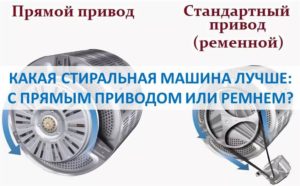 The presence of an inverter motor without a pulley and a drive belt is a serious argument when buying a washing machine for many buyers. The manufacturer generously praises their endless advantages, urging people to avoid traditional drive machines and quickly replace “old” models with modern ones. Is there any point in replacing them, how do washing machines really differ and which one, with direct drive or belt, should you buy? We’ll tell you below.
The presence of an inverter motor without a pulley and a drive belt is a serious argument when buying a washing machine for many buyers. The manufacturer generously praises their endless advantages, urging people to avoid traditional drive machines and quickly replace “old” models with modern ones. Is there any point in replacing them, how do washing machines really differ and which one, with direct drive or belt, should you buy? We’ll tell you below.
Let's compare two types of cars
For those who do not quite understand the difference between belt and direct drive, let us explain. The main difference concerns the method of transmitting energy from the engine, that is, how the drum rotates in the machine. There are two options here - directly from the electric motor or through the drive belt. Let's briefly describe each.
 Direct drive refers to the direct connection of the rotor to the drum axle. There is no belt system, but instead a special coupling is provided. There are no brushes on the surface of the motor, since the need for them is completely eliminated. This technology is called “Direct Drive”, since the inverter motor directly rotates the tank, and the speed is set by electromagnetic waves from the control board. Moreover, being under the hatch, the engine “reads” the weight of loaded items and automatically adjusts the appropriate power.
Direct drive refers to the direct connection of the rotor to the drum axle. There is no belt system, but instead a special coupling is provided. There are no brushes on the surface of the motor, since the need for them is completely eliminated. This technology is called “Direct Drive”, since the inverter motor directly rotates the tank, and the speed is set by electromagnetic waves from the control board. Moreover, being under the hatch, the engine “reads” the weight of loaded items and automatically adjusts the appropriate power.
In the second case, the drive belt connects the pulley of the tank and the engine, due to which the drum spins and stops. Rotation occurs smoothly due to the elasticity of the connecting rubber element, and the speed control depends on the type of motor.With a commutator device, a tachogenerator must be installed to control the rotational force, and special brushes smooth out friction and limit current transmission.
An asynchronous engine does not have such additions, is used in only 20% of household appliances, is cheap and has a stationary stator and a rotating rotor, the operation of which is automatically configured to repeat three phases with a certain number of revolutions.
It is impossible to say exactly which washing machine washes better and lasts longer without repair. One thing is clear - you should not blindly trust advertising: each has its own advantages and disadvantages. We will tell you more about all the “pros” and “cons” further.
Why are they promoting direct drive?
It is useless to argue: well-known brands zealously praise their inverter protégés through commercials, comparing the endless advantages of modern machines with the disadvantages of a traditional drive. The reason for the praise is simple - the manufacturer is trying to promote a more expensive product and get ahead of competitors. But the impression we get about sophisticated models is not entirely correct, since they are not without weaknesses, are subject to breakdowns and are not much better than traditional ones.
Let's start the analysis by considering the “advantages” of automatic machines with a drive belt:
- affordable price;
- the average period of trouble-free operation is up to 15 years;
- the entire load falls on the belt, the replacement of which is inexpensive and quick (about 20 minutes);
- If the laundry is unevenly distributed in the tank, the belt can act as shock absorbers.
The main thing is that such models have been tested for decades of mostly problem-free operation. Now about the disadvantages. These include a smaller tank size due to the need to fit a belt system inside the machine, as well as an increased noise level and regular replacement of constantly wearing electric brushes and a belt.
Advantages of machines with a new drive
It is difficult to find real reviews from consumers who have tried direct drive in action. Most comments repeat advertising slogans. If you combine all the information you come across, then direct drive machines have the following advantages.
- Compact with greater capacity. Quite likely, since the missing belt, brushes and pulley allow the drum to expand while the body shrinks.
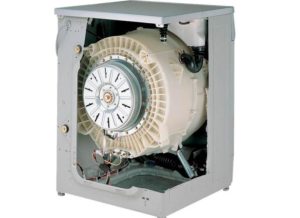
- Ten-year engine warranty. This is debatable, since in addition to the motor, other elements of the machine may break.
- Reduced noise and vibration levels. True, it is very insignificant, since the rustle from the constantly working belt is replaced by too noisy intake and drainage of water.
- Washing efficiency. They say that the expanded capabilities of the inverter motor with sharp stops and rotations in the opposite direction clean laundry better and fight the most stubborn stains. It is difficult to compare, since there were few complaints about traditional machines.
- Accelerated wash. The previously mentioned sharp operation of the inverter motor allows you to cycle faster, which saves a little time.
- Saving energy consumption. Due to the exclusion of some elements from the rotation chain and the ability to automatically control the required power by “reading” the weight of the loaded laundry.
- Diagnosis of the problem.The “Direct Drive” system is capable of signaling an excess of laundry in the tub by displaying a corresponding error, refusing to start the cycle, or randomly flashing indicators on the control panel.
In traditional machines, everything is different - the wash will begin and end due to a burnt or broken belt due to excessive load.
There are many “advantages”, but it is worth understanding that most of the listed advantages are relative and do not depend on the type of drive. So, with high-quality factory assembly, proper operation, ideal installation and the correct selection of detergents, even a belt machine will wash well and not make noise. Therefore, we take our time and compare specific models.
Disadvantages of “new” cars
Another argument in deciding which is better to buy from the offered range will be the weaknesses of direct-drive automatic machines. They exist and should be taken into account.
- High price. This applies to both the machine itself and its components and repair work.
- Dependence on uninterrupted electricity. The inverter motor is controlled by electronics, which are extremely vulnerable to power surges. It’s better to play it safe and connect a stabilizer to the device.
- Oil seal leaking. With a direct transmission, the motor is located directly under the tank, and if the oil seal is not replaced in a timely manner, leaks often occur. Water entering the engine causes breakdowns and even complete burnout. The warranty does not cover such a malfunction, and you will have to pay for expensive repairs out of your own pocket.
- Rapid wear of bearings. Without a belt and pulley, all the load from the rotating drum is transferred to closely spaced bearings. This increases their wear and requires regular replacement.
It is possible that the mentioned shortcomings are temporary and are due to a quick and not fully thought through transition from a belt to a direct drive. There is a high probability that in the future manufacturers will eliminate all weaknesses. In the meantime, inverter machines are too expensive and extremely unreliable, because a banal leak will lead to serious waste.
Cost of machines with different types of drive
The final choice between belt drive or direct drive will help you make a comparative review of specific models. We compared washing machines with similar technical characteristics to clearly show how much the inverter motor influences the market price. For the purity of the experiments, identical manufacturers were selected. Here are the results.
LG. Front-mounted machines F-80B8LD0 and F-80B8MD have a capacity of 5.5 kg, electronic control, equal dimensions (60/44/85 cm), class A+ energy consumption, level A washing efficiency and spin intensity up to 800 rpm. Other characteristics are also similar: the number of programs up to 15, a 19-hour delay start, identical functionality and body color. The first is with direct drive and costs about $250, the second with a belt and a price tag of $210-230.

Hotpoint-Ariston. Machines with a maximum load of up to 7 kg, a digital display, a high class of washing efficiency and low energy consumption - RST 702 X and VML 7023 B. Spin within 1000 rpm, 16 modes and equal power in other aspects. The price is significantly different: direct drive costs from 20,000 rubles, and with a belt – from 16,000 rubles.
Bosch. Models WAT 28541 and WAW 28740 differ only in the type of drive. Other indicators with hatch volume up to 9 kg, digital display, size, efficiency and consumption classes up to a spin speed of 1400 rpm are the same.The cost also varies: 47-50 thousand with a drive belt and from 70 thousand without it.
It is easy to notice that units of a new design are more expensive than their traditional counterparts, and the cooler the model, the higher the overpayment. Whether it is worth overpaying so much is up to each buyer to decide. We only recommend that you carefully weigh the pros and cons.
Interesting:
3 reader comments
Add a comment Cancel reply
Categories
Washing machine repair


For buyers

For users

Dishwasher

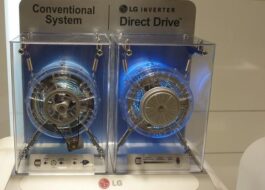
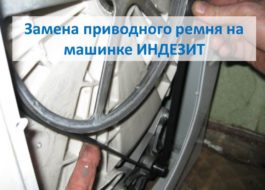

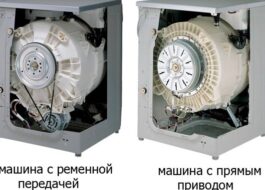
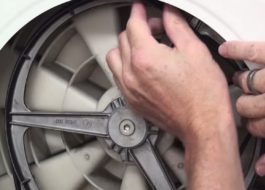
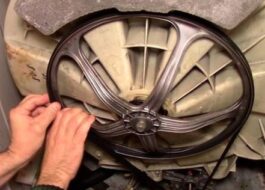










If the oil seal leaks, water does not enter the mortor.
The price difference is not very big
Yes, it seems like exactly the opposite, I saw that the same Bosch with belt drive was more expensive than with LG direct drive. You are confusing something, author. Hmm, 2019. Strange. Are you sure you go to large chain hardware stores and see the prices? I doubted something.